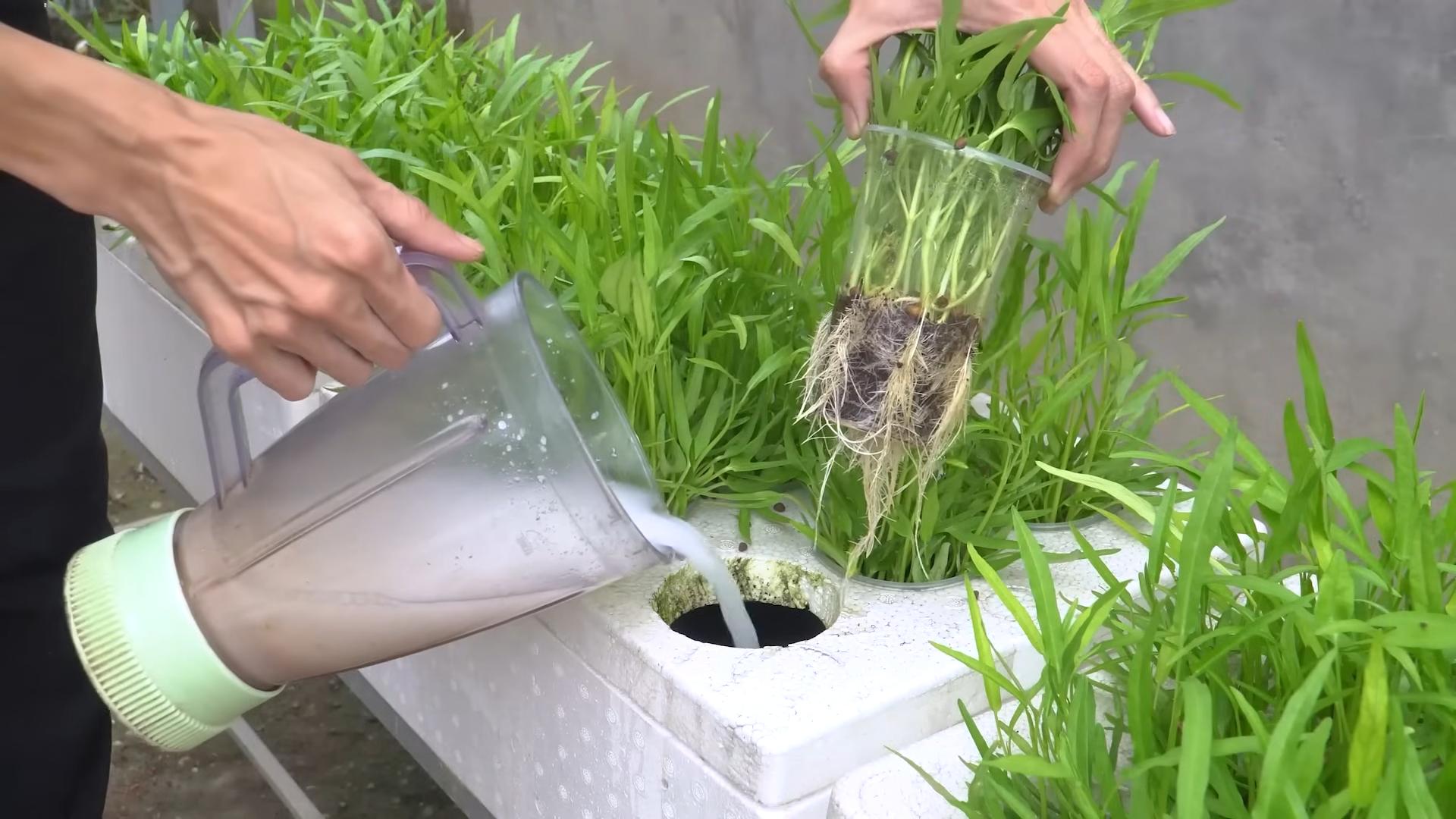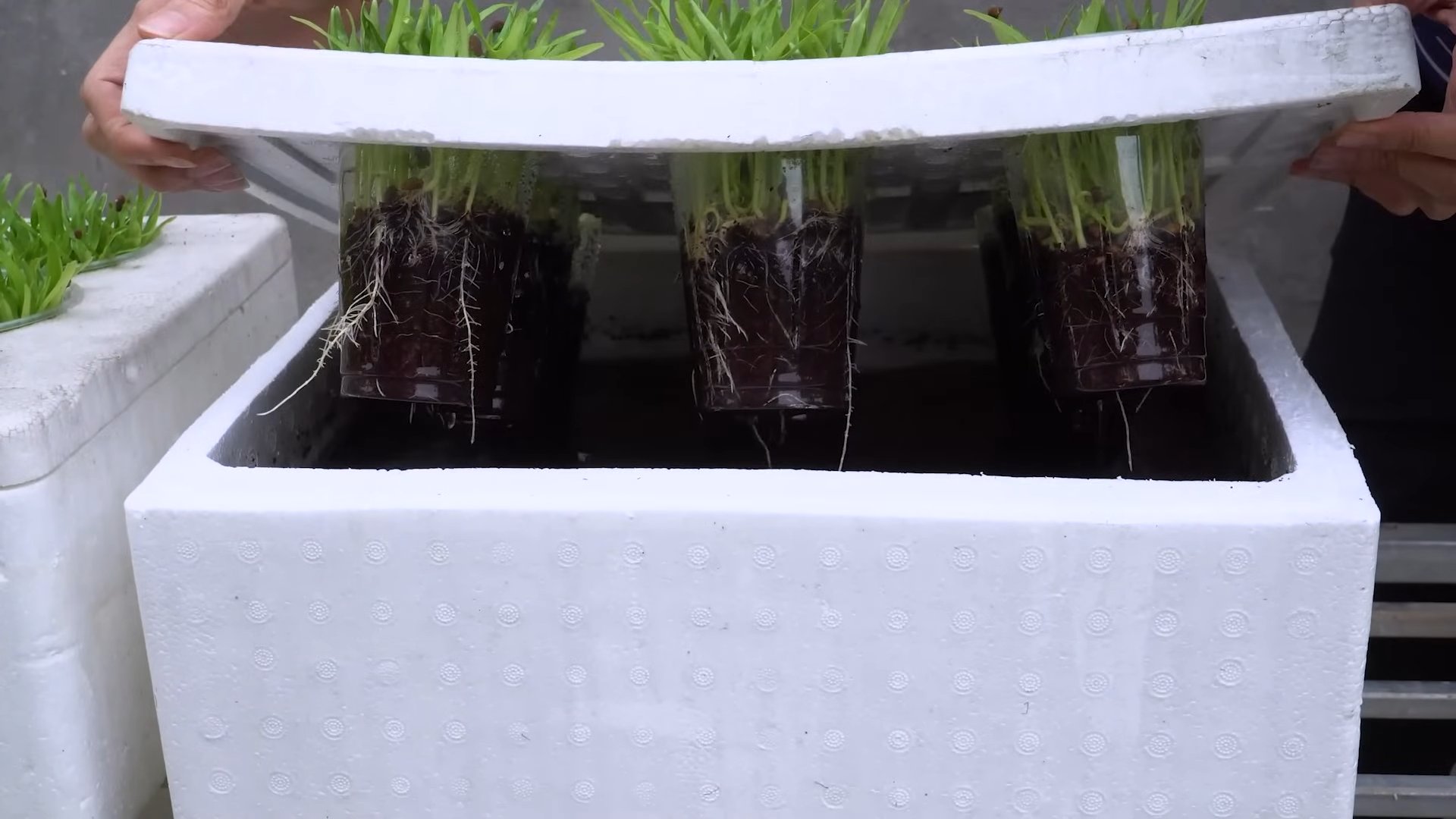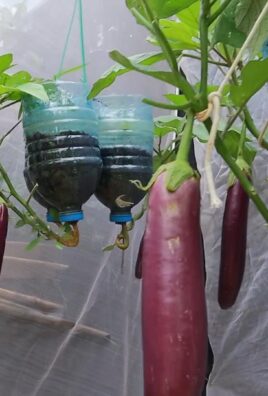Grow Water Spinach Home 鈥?sounds like a dream, right? Imagine stepping out into your backyard and harvesting fresh, vibrant water spinach, ready to be stir-fried or added to your favorite soup. It’s not just a dream; it’s an achievable reality with a few simple DIY tricks! For centuries, water spinach, also known as Ong Choy, has been a staple in Asian cuisine, gracing tables from bustling street food stalls to elegant family dinners. Its crisp texture and mild flavor make it incredibly versatile, and its nutritional benefits are undeniable.
But why should you bother growing it yourself? Well, store-bought water spinach can sometimes be a bit鈥acking. It might not be as fresh, or it could have traveled a long distance, losing some of its flavor and nutrients along the way. Plus, let’s be honest, there’s something incredibly satisfying about nurturing a plant from seed to table. I’m going to show you some easy and effective DIY methods to grow water spinach home, even if you have limited space or gardening experience. Get ready to unlock the secrets to a bountiful harvest and enjoy the freshest, most delicious water spinach you’ve ever tasted!

Growing Water Spinach at Home: A Beginner’s Guide
Hey there, fellow gardening enthusiasts! Ever wanted to grow your own fresh, leafy greens right in your backyard (or even on your balcony)? Well, today I’m going to walk you through the surprisingly simple process of growing water spinach, also known as Ong Choy or Kang Kong, at home. This delicious and nutritious vegetable is a staple in many Asian cuisines, and trust me, once you taste the homegrown version, you’ll never want to go back to store-bought!
Why Grow Water Spinach?
Before we dive in, let’s talk about why water spinach is such a great choice for home gardeners:
* Fast Growth: Water spinach is incredibly fast-growing. You can harvest your first crop in as little as 4-6 weeks!
* Easy to Grow: It’s relatively low-maintenance and thrives in warm, humid conditions.
* Nutritious: Packed with vitamins and minerals, water spinach is a healthy addition to your diet.
* Versatile: You can stir-fry it, add it to soups, or even eat it raw in salads.
* Space-Saving: It can be grown in containers, making it perfect for small spaces.
What You’ll Need
Okay, let’s gather our supplies. Here’s what you’ll need to get started:
* Water Spinach Seeds or Cuttings: You can find seeds online or at your local garden center. Alternatively, you can use cuttings from mature water spinach plants.
* Container or Growing Bed: Choose a container that’s at least 12 inches deep and wide. A plastic tub, a large pot, or even a repurposed container will work. If you have space, you can also grow it directly in a garden bed.
* Potting Mix: Use a well-draining potting mix that’s rich in organic matter.
* Water: Water spinach loves water, so make sure you have a reliable water source.
* Fertilizer: A balanced liquid fertilizer will help your water spinach thrive.
* Sunlight: Water spinach needs at least 4-6 hours of direct sunlight per day.
* Optional: A small pond or tub for hydroponic growing (more on this later!).
Starting from Seeds: A Step-by-Step Guide
If you’re starting from seeds, here’s how to do it:
1. Soak the Seeds: Before planting, soak the water spinach seeds in warm water for 24 hours. This will help soften the seed coat and improve germination. I usually put them in a small bowl and cover them with water.
2. Prepare the Container: Fill your container with potting mix, leaving about an inch of space at the top. Moisten the soil thoroughly.
3. Sow the Seeds: Sprinkle the seeds evenly over the surface of the soil. You don’t need to bury them too deep; just gently press them into the soil. I usually aim for about 1/4 inch depth.
4. Cover and Water: Cover the container with a clear plastic bag or plastic wrap to create a humid environment. This will help the seeds germinate. Water gently to avoid disturbing the seeds.
5. Germination: Place the container in a warm, sunny location. The seeds should germinate in about 5-10 days. Once the seedlings emerge, remove the plastic cover.
6. Thinning (Optional): If the seedlings are too crowded, you can thin them out, leaving about 2-3 inches between each plant. This will give them enough space to grow.
Starting from Cuttings: An Even Easier Method
Starting from cuttings is even easier than starting from seeds! Here’s how:
1. Obtain Cuttings: Get cuttings from a healthy, mature water spinach plant. The cuttings should be about 6-8 inches long and have at least a few nodes (the points where leaves grow). You can usually find these at Asian grocery stores.
2. Prepare the Cuttings: Remove the leaves from the bottom 2 inches of the cuttings. This will encourage root growth.
3. Rooting in Water: Place the cuttings in a glass or jar of water, making sure that the bottom nodes are submerged. Place the jar in a bright, indirect light location.
4. Wait for Roots: Change the water every 2-3 days. In about a week or two, you should see roots starting to grow.
5. Planting the Cuttings: Once the roots are about an inch long, you can plant the cuttings in your prepared container or growing bed.
Caring for Your Water Spinach
Now that your water spinach is planted, here’s how to keep it happy and healthy:
1. Watering: Water spinach needs plenty of water. Keep the soil consistently moist, but not waterlogged. I usually water mine every day, especially during hot weather.
2. Sunlight: Make sure your water spinach gets at least 4-6 hours of direct sunlight per day. If you’re growing it indoors, you may need to supplement with a grow light.
3. Fertilizing: Feed your water spinach with a balanced liquid fertilizer every 2-3 weeks. This will help it grow quickly and produce lots of leaves. Follow the instructions on the fertilizer label.
4. Pest Control: Water spinach is generally pest-resistant, but you may occasionally encounter aphids or spider mites. If you see any pests, you can spray them with insecticidal soap or neem oil.
Harvesting Your Water Spinach
The best part! You can start harvesting your water spinach when it’s about 6-8 inches tall.
1. Harvesting Method: Use scissors or a sharp knife to cut the stems about 2-3 inches above the soil line. This will encourage the plant to regrow.
2. Continuous Harvest: You can harvest your water spinach continuously throughout the growing season. Just keep cutting the stems as they grow.
3. Enjoy Your Harvest: Wash the harvested water spinach thoroughly and use it in your favorite recipes. It’s delicious in stir-fries, soups, and salads.
Hydroponic Water Spinach: Growing Without Soil
Want to try something a little different? You can also grow water spinach hydroponically, which means growing it without soil. Here’s how:
1. Prepare a Hydroponic Setup: You’ll need a container or tub filled with water, a net pot, and a hydroponic nutrient solution. You can buy these supplies online or at a hydroponics store.
2. Root Cuttings (if needed): If you’re starting from cuttings, root them in water as described above.
3. Plant in Net Pot: Place the rooted cuttings or seedlings in the net pot, using a growing medium like coco coir or perlite to support the roots.
4. Submerge Roots: Place the net pot in the container of water, making sure that the roots are submerged in the nutrient solution.
5. Maintain Water Level: Keep the water level consistent by adding water as needed. Change the nutrient solution every 1-2 weeks.
6. Provide Light: Make sure your hydroponic water spinach gets plenty of light, either from natural sunlight or a grow light.
7. Harvest: Harvest your hydroponic water spinach as described above.
Troubleshooting
Even with the best care, you might encounter a few problems. Here are some common issues and how to fix them:
* Yellowing Leaves: This could be a sign of nutrient deficiency. Try fertilizing your water spinach with a balanced liquid fertilizer.
* Slow Growth: This could be due to lack of sunlight or water. Make sure your water spinach is getting enough light and that the soil is consistently moist.
* Pests: As mentioned earlier, aphids and spider mites can sometimes be a problem. Spray them with insecticidal soap or neem oil.
* Leggy Growth: If your water spinach is growing tall and spindly, it’s probably not getting enough light. Move it to a sunnier location or supplement with a grow light.
Tips for Success
Here are a few extra tips to help you grow the best water spinach ever:
* Choose the Right Variety: There are several varieties of water spinach available. Some are better suited for growing in water, while others are better suited for growing in soil. Choose a variety that’s appropriate for your growing method.
* Provide Support: As your water spinach grows, it may need some support. You can use stakes or a trellis to keep the stems from falling over.
* Keep it Warm: Water spinach loves warm weather. If you live in a cooler climate, you may need to grow it indoors or in a greenhouse.
* Don’t Overcrowd: Give your water spinach plants enough space to grow. Overcrowding can lead

Conclusion
So, there you have it! Growing water spinach at home is not only achievable but surprisingly simple and rewarding. Forget those expensive grocery store prices and often wilted bunches. With this easy DIY trick, you can have a constant supply of fresh, crisp, and vibrant water spinach right at your fingertips.
Why is this a must-try? Because it puts you in control. You know exactly where your food is coming from, what’s been used to grow it (or not used, if you opt for organic methods!), and you get the unparalleled satisfaction of harvesting something you nurtured yourself. Plus, it’s a fantastic way to reduce your carbon footprint and contribute to a more sustainable lifestyle.
But the fun doesn’t stop there! Feel free to experiment with different growing mediums. While we’ve focused on a simple water-based system, you can also try growing your water spinach in soil-filled containers, ensuring they are consistently moist. Consider adding a diluted liquid fertilizer every couple of weeks to boost growth and nutrient content.
Another variation to explore is growing different varieties of water spinach. There are several cultivars available, each with slightly different leaf shapes, stem thicknesses, and flavor profiles. Research what’s available in your region and see which one you prefer.
Don’t be afraid to get creative with your setup! Use recycled containers, build a small hydroponic system, or even dedicate a corner of your garden to this versatile vegetable. The possibilities are endless.
The key to success with this DIY trick is consistency. Regularly check the water level, ensure adequate sunlight, and harvest frequently to encourage new growth. With a little bit of care and attention, you’ll be enjoying delicious water spinach in no time.
We are confident that once you try growing water spinach at home using this method, you’ll be hooked. It’s a fun, educational, and ultimately delicious experience. So, grab your supplies, follow the steps outlined, and get ready to harvest your own homegrown goodness.
Now, we want to hear from you! Have you tried growing water spinach at home before? What challenges did you face? What tips and tricks do you have to share? We encourage you to try this DIY trick and share your experiences in the comments below. Let’s build a community of home gardeners and learn from each other. Don’t forget to post pictures of your water spinach harvests! We can’t wait to see your success stories. Happy growing!
Frequently Asked Questions (FAQ)
What exactly is water spinach, and why should I grow it?
Water spinach, also known as Ong Choy or Kang Kong, is a leafy green vegetable popular in Asian cuisine. It’s known for its mild, slightly sweet flavor and crisp texture. It’s incredibly versatile and can be stir-fried, steamed, boiled, or added to soups and salads. Growing it yourself ensures you have access to fresh, pesticide-free greens whenever you need them, and it’s significantly cheaper than buying it from the store. Plus, it’s a fast-growing plant, so you’ll see results quickly!
How much sunlight does water spinach need?
Water spinach thrives in full sun, meaning it needs at least 6-8 hours of direct sunlight per day. If you’re growing it indoors, place it near a sunny window or supplement with grow lights. Insufficient sunlight can lead to leggy growth and reduced yields.
What kind of water should I use?
Tap water is generally fine, but it’s best to let it sit out for 24 hours to allow chlorine to dissipate. You can also use filtered water or rainwater. Avoid using water that is heavily chlorinated or contains high levels of minerals, as this can harm the plants. Regularly changing the water is crucial to prevent algae growth and maintain a healthy growing environment.
How often should I change the water?
This depends on the size of your container and the growing conditions. As a general rule, change the water every 3-5 days. If you notice the water becoming cloudy or developing an odor, change it more frequently. Regular water changes help prevent the buildup of algae and harmful bacteria.
Can I grow water spinach indoors year-round?
Yes, you can! With adequate sunlight (either natural or artificial) and a consistent water supply, you can grow water spinach indoors year-round. Just be sure to monitor the temperature and humidity levels, as water spinach prefers warm and humid conditions.
How do I harvest water spinach?
Harvesting water spinach is easy. Simply cut the stems about 4-6 inches from the base of the plant. This will encourage new growth and allow you to harvest multiple times. You can harvest as needed, but regular harvesting will promote bushier growth.
How long does it take to grow water spinach from seed?
Water spinach is a fast grower. You can typically expect to harvest your first crop within 4-6 weeks of planting the seeds. The exact time will depend on the growing conditions, such as temperature, sunlight, and nutrient availability.
What are some common problems when growing water spinach, and how can I fix them?
Some common problems include algae growth, nutrient deficiencies, and pest infestations. Algae growth can be prevented by regularly changing the water and ensuring adequate sunlight. Nutrient deficiencies can be addressed by adding a diluted liquid fertilizer. Pest infestations are rare, but if you notice any pests, you can try spraying the plants with insecticidal soap.
Can I use fertilizer when growing water spinach?
Yes, you can use a diluted liquid fertilizer to boost growth and nutrient content. Choose a fertilizer that is specifically formulated for leafy greens and follow the instructions on the label. Avoid over-fertilizing, as this can harm the plants. A balanced fertilizer will provide the necessary nutrients for healthy growth.
Is water spinach safe to eat?
Yes, water spinach is generally safe to eat. However, it’s important to wash it thoroughly before consumption to remove any dirt or debris. If you’re growing it in a water source that may be contaminated, it’s best to cook it before eating.
What are some delicious ways to cook water spinach?
Water spinach is incredibly versatile and can be used in a variety of dishes. It’s commonly stir-fried with garlic and chili, added to soups and stews, or used in salads. It can also be steamed or boiled. Experiment with different recipes and find your favorite way to enjoy this delicious vegetable.
Can I grow water spinach in a container with soil instead of just water?
Yes, you can absolutely grow water spinach in a container with soil. Ensure the container has drainage holes and use a well-draining potting mix. Keep the soil consistently moist, as water spinach prefers wet conditions. You may need to water more frequently than if you were growing it in water.
How do I save seeds from my water spinach plants?
Allow some of your water spinach plants to flower and produce seeds. Once the seed pods are dry and brown, harvest them and extract the seeds. Store the seeds in a cool, dry place until you’re ready to plant them. Saving seeds allows you to continue growing water spinach year after year.
Is growing water spinach at home a good way to save money?
Absolutely! Growing water spinach at home can significantly reduce your grocery bill, especially if you consume it regularly. The initial investment in seeds and supplies is minimal, and you’ll be able to harvest multiple crops from a single plant. Plus, you’ll have the satisfaction of knowing you’re growing your own food sustainably.




Leave a Comment